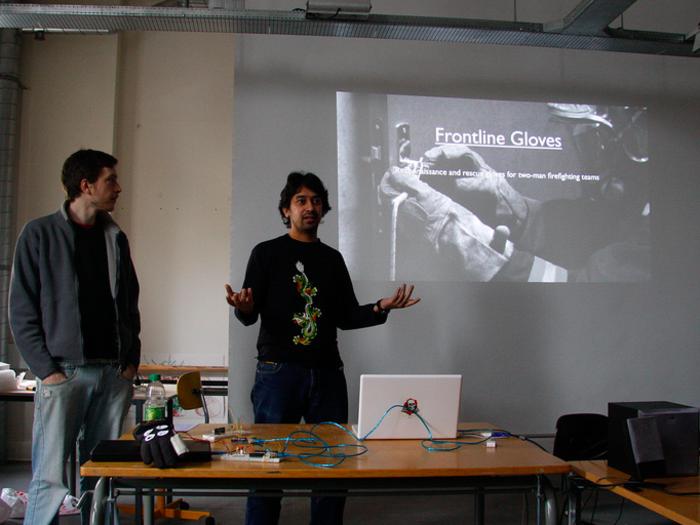13 public speaking habits to avoid at all costs
1. Not tailoring your message to your audience.

2. Letting your eyes dart around the room.

From beginners to veterans, the majority of speakers fail to maintain meaningful, sustained eye contact with their listeners.
"Unconsciously, their eyes scurry from person to person, darting around the room, without ever pausing to actually see the recipients of their message," Price says. "A lack of eye contact implies a list of offenses: insincerity, disinterest, detachment, insecurity, shiftiness, and even arrogance."
To visually connect, maintain eye contact for at least two to three seconds per person, or long enough to complete a full phrase or sentence. Effective eye communication is the most important nonverbal skill in a speaker's toolbox.
3. Not crafting a powerful opening.

"According to Plato, 'The beginning is the most important part of the work.' Yet, it's a common bad habit for speakers to waste those precious opening seconds rambling pointlessly, telling a joke, reading an agenda, apologizing needlessly, all of which fail to grab the audience's attention and motivate them to listen," she says. You, your message, and your audience deserve much more.
So, open with a bang.? Invest the thought, time, and effort to craft and memorize "the most important part of the work." For example, tell an engaging, relevant story; state a startling statistic; or ask a thought-provoking question.
4. Distracting mannerisms.

There are at least 20 common tics to tackle, including: clenching or wringing your hands, pacing back and forth, keeping your hands in pockets, jingling change or keys, twisting your ring, gripping the lectern, licking your lips, adjusting your hair or clothing, fidgeting with a pen, bobbing your head, placing your arms behind your back, and touching your face.
"One or more of these habits can distract the audience from your message and jeopardize your credibility," Price explains.
As a remedy, record yourself speaking and watch the playback. "Practice often to increase your comfort level and reduce anxiety," she says. "Take a public speaking class or enlist the help of a local coach to eliminate distracting mannerisms and habituate purposeful movement."
5. Not rehearsing.

Most proficient presenters prepare. "That is, they know the topic, organize their content, design a slide deck, and study their notes," she says.
However, according to a survey Price conducted, less than 2% of over 5,000 business presenters in Fortune 100 companies actually conduct a dress rehearsal and practice their presentation aloud.
"This bad habit results in the audience seeing and hearing the unrefined run-through, versus the finessed final performance," she says. "To optimize their perception of you and get the outcome you want, perform the entire presentation aloud at least once, and the opening and closing at least three times."
6. Discussing how nervous you are.

If you're nervous, your body language may or may not give it away to the audience. But it's perfectly normal to be nervous — and most audience members will understand and won't mind one bit.
However, telling everyone how nervous you are may make them feel uncomfortable, and it will just draw more attention to the signs that people might have never noticed in the first place. So don't do it, no matter how tempted you are.
7. Having low energy.

"As the Guinness World Record holder for the most performances in the same Broadway show, George Lee Andrews is famous for playing the role of Monsieur André in The Phantom of the Opera," Price says.
"Surely, he must have felt tired during at least one or two of his 9,382 performances, but he didn't show it, considering his contract was renewed 45 times over 23 years."
Enthusiasm, defined as eager enjoyment and active interest, is an audience's most desired trait in a presenter. Conversely, a boring delivery — evidenced by a low monotone voice, dull facial expressions, and overall lethargy — is their most disliked trait.
"To avoid losing your audience in a New York minute, crank up the energy level. Speak expressively, smile sincerely, move naturally, and enjoy the moment."
8. Data dumping.

"It's understandable. After all, our credibility is on the line when we stand up and speak out," Price says. "So, to be safe, we focus almost entirely on what Aristotle called Logos, which includes the left-brain functions of logic, language, analysis, reasoning, critical thinking, and numbers."
When we rely too heavily on this type of content, we end up talking too long, reading too many over-crowded illegible slides, and turning our backs on the most important element of all: the audience. "Ditch the habit of data dumping," she suggests. "It loses the audience and undermines your innate ability to inspire, connect, and persuade."
9. Not inspiring your audience.

Even more vital to persuasion than Logos, says Aristotle, is Pathos, which includes the right-brain activities of emotions, images, stories, examples, empathy, humor, imagination, color, sounds, touch, and rapport, Price says.
"Tomes of studies show human beings typically make decisions based on emotions first (Pathos); then, we look for the facts and figures to justify it (Logos). Audience members do the same. With your words, actions, and visuals, seek first to inspire an emotion in them (joy, surprise, hope, excitement, love, empathy, vulnerability, sadness, fear, envy, guilt). Then, deliver the analysis to justify the emotion."
An engaging, memorable, and persuasive presentation is balanced with both information and inspiration. "It speaks to the head and the heart, leveraging both facts and feelings," she says.
10. Forgetting to pause.

Many speakers have the bad habit of rushing through their content. Like a runaway train, they speed down the track out of control unable to stop and turn at critical junctures. The causes are often anxiety, adrenaline, or time constraints, Price says.
"Regardless of the reason, the three times you definitely want to pause include: before and after you say something very important which you want your audience to remember; before and after you transition from one key talking point to the next; and between your opening, main body and closing."
When you consciously use silence as a rhetorical device, you'll come across as more self-confident, your message will be more impactful, and your audience will remember more of what you say.
11. Ending with Q&A.

There's a good chance you've heard a speaker end an otherwise effective presentation with an abrupt, 'That's it. Any questions?' "For the audience, it's like a firework with a wet fuse, otherwise known as a 'dud,'" Price says.
"Your grand finale is your last chance to reinforce your key points, ensure the memorability of your message, and motivate the audience to action. Avoid the bad habit of closing on Q&A, which risks ending your presentation on a non-climatic down-in-the-weeds topic."
It's fine to invite the audience's comments and questions; however, be sure to end strong.
"Craft an effective three-part closing where you deliver a strong summary; present a call-to-action; and conclude with a powerful closing statement. Develop the habit of saying last what you want your audience to remember most," she concludes.
12. Reading from your slides.

A slideshow can be very helpful for jogging your memory and reinforcing the main points of the presentation to your audience.
However, as Inc. contributing editor Geoffrey James points out, the people watching your presentation can read, so giving them the exact same information verbally and visually can be boring and insulting.
"Use slides as visual signposts for the points you're making rather than a written version or summary of those points," James writes for Inc.
13. Making an excuse or an apology.

Perhaps you're running late and want to let your audience know why. Or maybe you just stepped off a long flight and want to explain why your performance might not be as strong as it would otherwise.
Either way, making an excuse or an apology sets a negative tone and gives people a reason to think your presentation was underwhelming. Instead, take any personal mishaps in stride and let the audience evaluate your performance independently.
"Regardless of how you're feeling, show enthusiasm for being there and make your best effort," James writes.
Popular Right Now
Popular Keywords
Advertisement